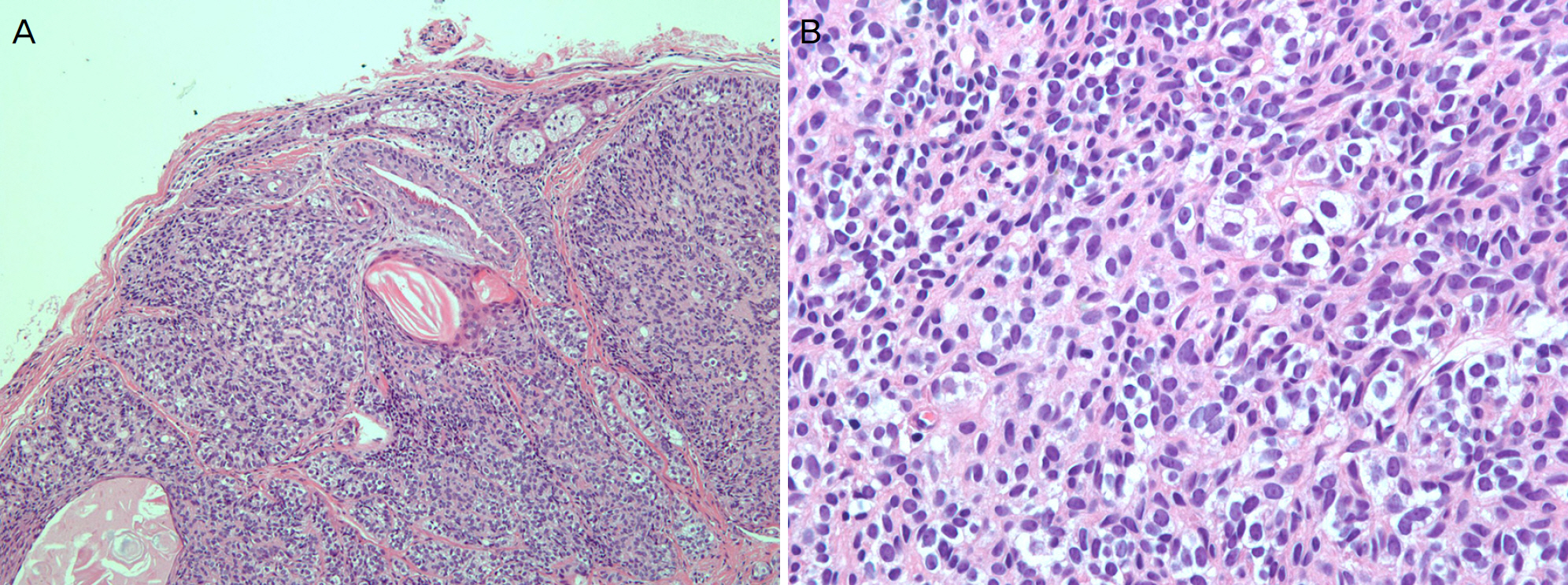J Korean Ophthalmol Soc.
2016 Aug;57(8):1303-1306. 10.3341/jkos.2016.57.8.1303.
A Case of Eyelid Sebaceoma Mimicking Chalazion
- Affiliations
-
- 1Department of Ophthalmology, Hallym University Sacred Heart Hospital, Hallym University College of Medicine, Anyang, Korea. minjounglee77@gmail.com
- 2Department of Pathology, Hallym University Sacred Heart Hospital, Hallym University College of Medicine, Anyang, Korea.
- KMID: 2349080
- DOI: http://doi.org/10.3341/jkos.2016.57.8.1303
Abstract
- PURPOSE
To report a rare case of sebaceoma misdiagnosed as chalazion.
CASE SUMMARY
A 42-year-old female presented with a visible mass in her right lower eyelid. An elevated, hard mass was located at the margin of the right lower eyelid, and she had a history of incision and curettage under the clinical impression of chalazion. On eversion of the lower eyelid, the tarsal portion of the mass was visible as a white-yellowish lesion. The mass was excised under local anesthesia. A sebaceoma was diagnosed based on histopathological examinations. Immunohistochemical studies showed positive staining results for mutator L homologue 1 (MLH1), mutator S homologue 2 (MSH2), and mutator S homologue 6 (MSH6), and she had no past medical history or family history of internal malignancy, suggesting a low possibility of Muir-Torre syndrome.
CONCLUSIONS
Eyelid sebaceoma should be considered as a differential diagnosis for refractory chalazion.
Keyword
MeSH Terms
Figure
Reference
-
References
1. Troy JL, Ackerman AB. Sebaceoma. A distinctive benign neoplasm of adnexal epithelium differentiating toward sebaceous cells. Am J Dermatopathol. 1984; 6:7–13.2. Lazar AJ, Lyle S, Calonje E. Sebaceous neoplasia and Torre-Muir syndrome. Curr Diagn Pathol. 2007; 13:301–19.
Article3. Cohen PR, Kohn SR, Kurzrock R. Association of sebaceous gland tumors and internal malignancy: the Muir-Torre syndrome. Am J Med. 1991; 90:606–13.
Article4. John AM, Schwartz RA. Muir-Torre syndrome (MTS): An update and approach to diagnosis and management. J Am Acad Dermatol. 2016; 74:558–66.
Article5. Al-Khashnam H, Burezq H, Al-Aradi I, et al. Unusual malignant transformation of recurrent sebaceoma. A case report. Clin Med Oncol. 2008; 2:389–92.6. Shalin SC, Lyle S, Calonje E, Lazar AJ. Sebaceous neoplasia and the Muir-Torre syndrome: important connections with clinical implications. Histopathology. 2010; 56:133–47.
Article7. Yonekawa Y, Jakobiec FA, Zakka FR, Fay A. Sebaceoma of the eyelid. Ophthalmology. 2012; 119:2645.e1–4.
Article8. Mittal R, Tripathy D. Sebaceoma of the eyelid: a rare entity. Can J Ophthalmol. 2014; 49:e78–80.
Article9. Kwon JS, Choi JG, Song GY, Park IK. A case of sebaceous abdominal on the lower palpebral conjunctiva. J Korean Ophthalmol Soc. 2003; 44:508–10.10. Cesinaro AM, Ubiali A, Sighinolfi P, et al. Mismatch repair abdominal expression and microsatellite instability in skin lesions with sebaceous differentiation: a study in different clinical subgroups with and without extracutaneous cancer. Am J Dermatopathol. 2007; 29:351–8.11. Kruse R, Ruzicka T. DNA mismatch repair and the significance of a sebaceous skin tumor for visceral cancer prevention. Trends Mol Med. 2004; 10:136–41.
Article12. Ko CJ. Muir-Torre syndrome: facts and controversies. Clin Dermatol. 2010; 28:324–9.
Article




